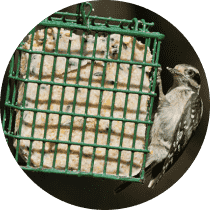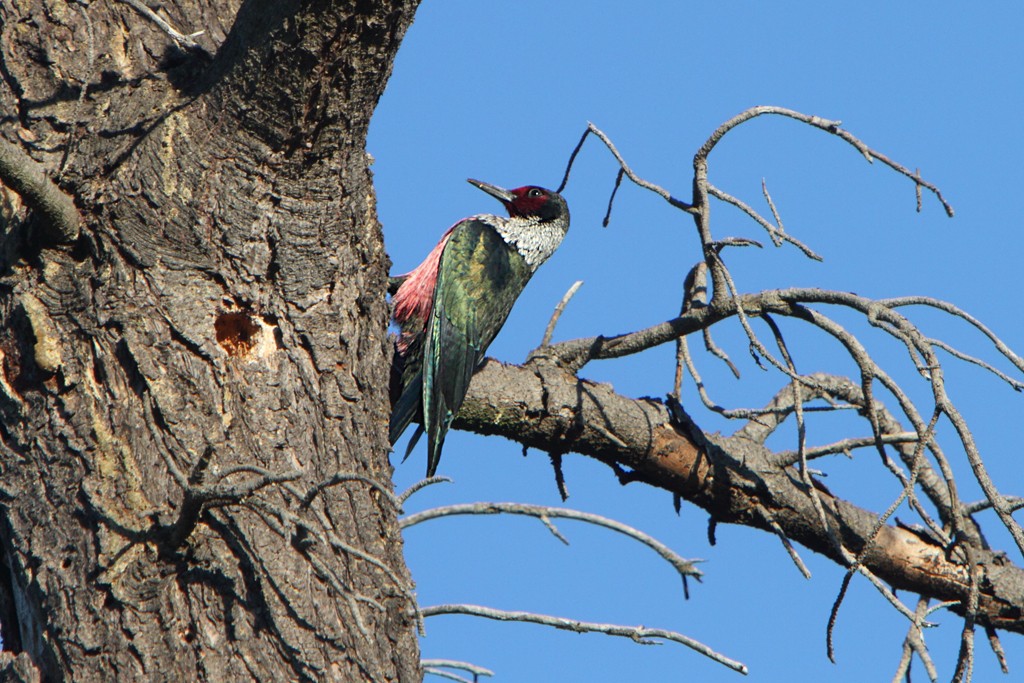Lewis's Woodpecker
A species of Melanerpine Woodpeckers Scientific name : Melanerpes lewis Genus : Melanerpine Woodpeckers
Lewis's Woodpecker, A species of Melanerpine Woodpeckers
Botanical name: Melanerpes lewis
Genus: Melanerpine Woodpeckers
Content
Description General Info
Description
One of the largest species of American woodpeckers, Lewis's woodpecker can measure up to 10–11 inches (25–28 cm) in length. It is mainly reddish-breasted, blackish-green in color with a black rump. It has a gray collar and upper breast, with a pinkish belly, and a red face. The wings are much broader than those of other woodpeckers, and it flies at a much more sluggish pace with slow, but even flaps similar to those of a crow. Its calls have a harsh sound relative to other woodpeckers', and it may use a repertoire of several different phrases. Measurements: Length: 10.2-11.0 in (26-28 cm) Weight: 3.1-4.9 oz (88-138 g) Wingspan: 19.3-20.5 in (49-52 cm) 
Size
25-29 cm (10-11.5 in)
Nest Placement
Cavity
Clutch Size
5 - 9 eggs
Incubation Period
1 brood
Number of Broods
12 - 16 days
Nestling Period
28 - 34 days
Feeding Habits
Lewis's Woodpecker primarily consume free-living insects, acorns, nuts, and fruits. They uniquely catch flying insects midair and glean from branches, differing from typical woodpecker foraging. In fall and winter, they store nuts and grains in cottonwood tree crevices.
Habitat
Lewis's Woodpecker inhabits a variety of open woodlands, often favoring open ponderosa pine forests, riparian woodlands with cottonwood, and areas with significant snag presence due to logging or natural fires. These birds are also found in oak and piñon pine–juniper woodlands, as well as agricultural and orchard landscapes. They thrive at various altitudes, adapting to the climate of both mountainous regions and lower valleys. During nonbreeding seasons, lewis's Woodpecker adopts a nomadic lifestyle, seeking out resources in cottonwood-lined streams, orchards, and oak woodlands.
Nest Behavior
Using pre-existing cavities, lewis's Woodpecker's nesting includes modifying them as needed, with little further construction. Egg-laying follows seasonal patterns, and both parents partake in egg incubation and feeding the hatchlings.
Nest Characteristics
Lewis's Woodpecker typically nests in holes of dead or decaying trees like cottonwood or ponderosa pine. These cavities, often formed by other species or natural decay, may be in live trees occasionally. Lewis's Woodpecker remodels or enlarges the holes, lining them with wood chips.,
Dite type
Insectivorous
General Info
Feeding Habits
Bird food type
Bird Feeder Type

Suet Cage
Behavior
Lewis's Woodpecker exhibit a unique mix of behaviors uncharacteristic of many other woodpecker species. Daily, they hitch up trees in a recognizable woodpecker way, yet they distinctly perch on branches, posts, and wires in an erect posture. They engage in flycatcher-like pursuits, swooping from perches to snag insects mid-flight. Come fall and winter, lewis's Woodpecker's diet shifts predominantly to acorns and nuts, which they meticulously cache in tree barks. These stores are fiercely defended from intruders, with displays of bill-raising, wing-flaring, and vibrant underbelly exposure. They are especially combative towards other woodpeckers contesting their reserves. Notably, males perform similar wing-lifting and orbiting displays during courtship. Post-breeding, some lewis's Woodpecker either form nomadic groups in search of food or disperse to lower altitudes, while others remain in their habitual locales.
Species Status
Not globally threatened.
Scientific Classification
Phylum
Chordates Class
Birds Family
Woodpeckers Genus
Melanerpine Woodpeckers Species
Lewis's Woodpecker 